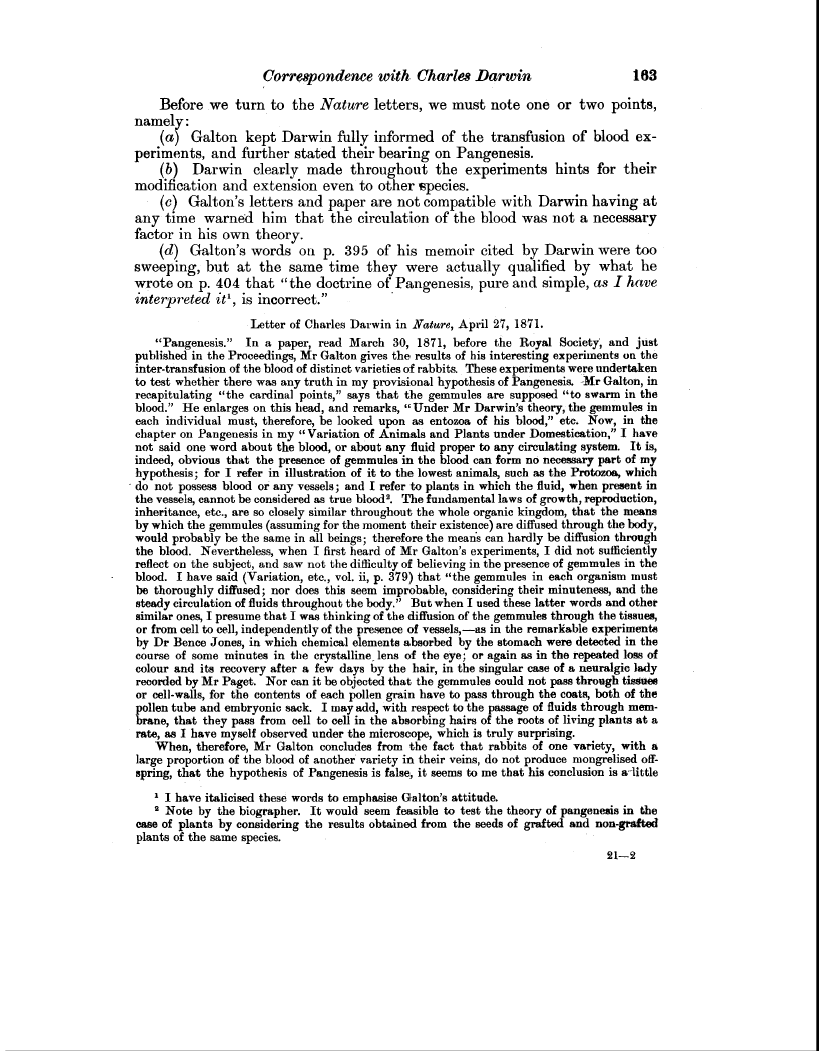Correspondence with Charles Darwin 183
Before we turn to the Nature letters, we must note one or two points, namely
(a) Galton kept Darwin fully informed of the transfusion of blood experiments, and further stated their bearing on Pangenesis.
(b) Darwin clearly made throughout the experiments hints for their modification and extension even to other species.
(c) Galton's letters and paper are not compatible with Darwin having at any time warned hint that the circulation of the blood was not a necessary factor in his own theory.
(d) Galton's words on p. 395 of his memoir cited by Darwin were too sweeping, but at the same time they were actually qualified by what he wrote on p. 404 that "the doctrine of Pangenesis, pure and simple, as I have interpreted it', is incorrect."
Letter of Charles Darwin in Nature, April 27, 1871.
"Pangenesis." In a paper, read March 30, 1871, before the Royal Society, and just published in the Proceedings, Mr Galton gives the results of his interesting experiments on the inter-transfusion of the blood of distinct varieties of rabbits. These experiments were undertaken to test whether there was any truth in my provisional hypothesis of Pangenesis. -Mr Galton, in recapitulating "the cardinal points," says that the gemmules are supposed "to swarm in the blood." He enlarges on this head, and remarks, "Under Mr Darwin's theory, the gemmules in each individual must, therefore, be looked upon as entozoa of his blood," etc. Now, in the chapter on Pangenesis in my "Variation of Animals and Plants under Domestication," I have not said one word about the blood, or about any fluid proper to any circulating system. It is, indeed, obvious that the presence of gemmules in the blood can form no necessary part of my hypothesis; for I refer in illustration of it to the lowest animals, such as the Protozoa, which do not possess blood or any vessels; and I refer to plants in which the fluid, when present in the vessels, cannot be considered as true blood'. The fundamental laws of growth, reproduction, inheritance, etc., are so closely similar throughout the whole organic kingdom, that the means by which the gemmules (assuming for the moment their existence) are diffused through the body, would probably be the same in all beings; therefore the means can hardly be diffusion through the blood. Nevertheless, when I first heard of Mr Galton's experiments, I did not sufficiently reflect on the subject, and saw not the difficulty of believing in the presence of gemmules in the blood. I have said (Variation, etc., vol. ii, p. 379) that "the gemmules in each organism must be thoroughly diffused; nor does this seem improbable, considering their minuteness, and the steady circulation of fluids throughout the body." But when I used these latter words and other similar ones, I presume that I was thinking of the diffusion of the gemmules through the tissues, or from cell to cell, independently of the presence of vessels,-as in the remarkable experiments by Dr Bence Jones, in which chemical elements absorbed by the stomach were detected in the course of some minutes in the crystalline, lens of the eye; or again as in the repeated loss of colour and its recovery after a few days by the hair, in the singular case of a neuralgic lady recorded by Mr Paget. Nor can it be objected that the gemmules could not pass through tissues or cell-walls, for the contents of each pollen grain have to pass through the coats, both of the pollen tube and embryonic sack. I may add, with respect to the passage of fluids through membrane, that they pass from cell to cell in the absorbing hairs of the roots of living plants at a rate, as I have myself observed under the microscope, which is truly surprising.
When, therefore, Mr Galton concludes from the fact that rabbits of one variety, with a large proportion of the blood of another variety in their veins, do not produce mongrelised offspring, that the hypothesis of Pangenesis is false, it seems to me that his conclusion is a -little
' I have italicised these words to emphasise Galton's attitude.
2 Note by the biographer. It would seem feasible to test the theory of pangenesis in the case of plants by considering the results obtained from the seeds of grafted and non-grafted plants of the same species.
21-2

